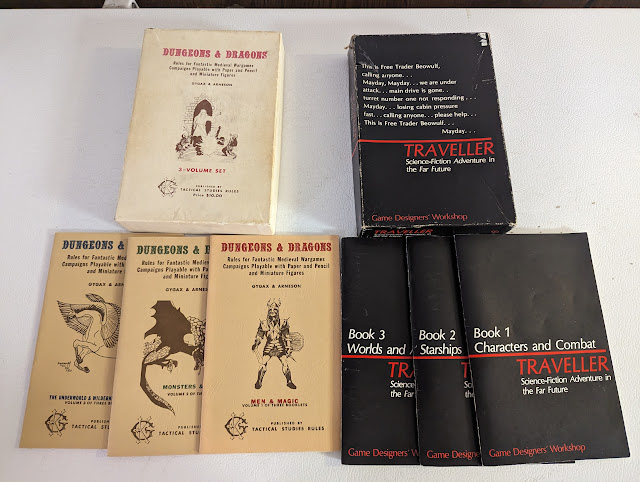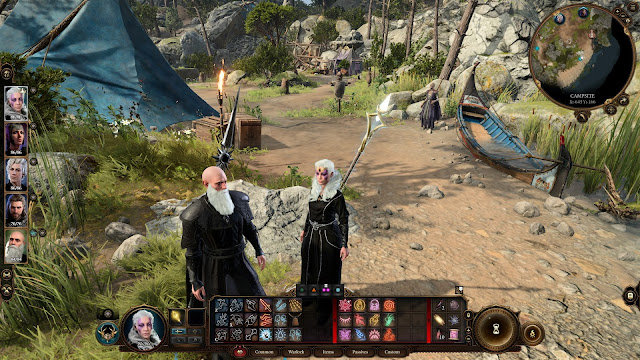I have an inordinate amount of Queens in my games. I am going to talk about two groups in particular, the Vampire Queens and the Witch Queens.
 |
| Tea with the Witch Queens by Brian Brinlee |
Both groups are near and dear to my heart and make up a lot of my game worlds' backgrounds.
The Vampire Queens
The vampire queens have a special connection to my early days of gaming. They are:
- There is the (unnamed) Vampire Queen of "Palace of the Vampire Queen," one of the earliest published D&D adventures.
- Lady Neeblack of "The Hanging Coffins of the Vampire Queen."
- Queen Xaltana of The Lost Caverns of Acheron.
- Darlessa, the vampire Queen who killed my first character and antagonist of my #Dungeon23 adventure.
- Human witch stats
- Vampire stats (Labyrinth Lord)
- Vampire stats (Old-school Essentials)
- Vampire stats (Wasted Lands)
- As a Ravenloft Darklord
I have been using vampire queens in my adventures for as long as I can remember. I recall reading lurid tales of Erzsébet Báthory and watching movies like "Daughters of Darkness" and "Countess Dracula." I had worked on a very early vampire queen, who was going to be called "Miriam" thanks to "The Hunger" for my Ravenloft games (see tomorrow), but I kept coming up with so many ideas. Miriam is still out there, even if many of her aspects are now part of Darlessa. The non-vampire parts of Miriam survived as my Witch Queen Miriam.
In truth I kind of use them all interchangeably, with some emphasis on Darlessa. As they have all evolved in my games, I am slowly sifting out which traits belong to which queen.
Interestingly enough, both Darlessa and Xaltana are also both Witch Queens. Xaltana combines Iggwilv (a witch queen) and Drelzna her vampire daughter.
The Witch Queens
While the Vampire Queens are here to challenge the characters as adversaries, the Witch Queens play a much different and far more wide-reaching role.
This began as an idea of me finding and then stating up every witch ever mentioned in the pages of a D&D or related game. The premise here was that every 13 years the witches of these worlds would meet in one place to discuss what they are up to in their worlds and plan to generally stay out of each other's way. The gathering, known as the Tredecim, became a big part of my games. At the Tredecim, the 13 ruling witches then choose a new High Witch Queen to serve over the next 13 years. In my campaign, War of the Witch Queens, the then-current High Witch Queen is murdered before a new one can be chosen. This sends the witches into war against each other, but due to their pacts with Baba Yaga, they can't outright fight each other. So, all their worlds get dragged into the conflict. This includes the characters.
The characters learn first that a once-in-a-century storm has destroyed their home, and they are refugees helping move their fellow town folk to a new home in East Haven. While their first obvious goal is to stop all the weird happenings going on in their own world, they discover these events are playing out across the worlds. To stop it, they need to stop the all-powerful Witch Queens, but to do that, they will need to discover who murdered the High Queen, how, and why.
Since I started working on this and developing it more and more, I have gone over 13 Witch Queens and my planned 13 Adventures. I am using Basic B/X D&D as my rules of choice here, which limits the levels characters can achieve to 14.
I am running it with my family now, but I'd also like to run it for a dedicated group someday. I think for that I would take all the adventures I am using for it and edit them all a bit.
If I keep the levels 1-14 then the obvious choice is D&D Basic B/X. If I expand it all to level 20 then my choice will be Castles & Crusades.
Either way, I have a lot to look forward to!
Tomorrow is R Day, and I am going with the campaign setting I ran for all of the AD&D 2nd Edition era, Ravenloft.
OH? Like the art of my Witch Queens up there? The artist is Brian Brinlee and he has a Kickstarter of his new art book going on now! Check it out.




























